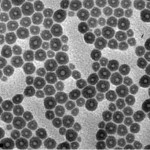 The larval form of the midge (left) and the adult. Denlinger Lab, Ohio State When the term “extremophiles” gets thrown around, it’s usually in reference to single-celled organisms that thrive in high salt or near-boiling water. But there are a few animals that also manage to make do in rather extreme conditions. Perhaps the top example is a wingless midge that goes by Belgica antarctica . As its name implies, it’s native to the frozen continent—in fact, it’s the only insect that’s native. (A few others have more recently introduced themselves from South America in recent years, and cockroaches undoubtedly ride in shipments to research bases.) Now, to try to help understand how anything can survive in such inhospitable conditions, researchers sequenced the genome of the midge and discovered it’s gotten rid of a lot of the DNA that’s frequently termed junk. The researchers describe just how difficult the insect’s living conditions are in detail: “The larvae, encased in ice for most of the year, require two years to complete their development and then pupate and emerge as adults at the beginning of their third austral summer. The [wingless] adults crawl over surfaces of rocks and other substrates, mate, lay eggs and die within 7–10 days after emergence.” Read 8 remaining paragraphs | Comments
The larval form of the midge (left) and the adult. Denlinger Lab, Ohio State When the term “extremophiles” gets thrown around, it’s usually in reference to single-celled organisms that thrive in high salt or near-boiling water. But there are a few animals that also manage to make do in rather extreme conditions. Perhaps the top example is a wingless midge that goes by Belgica antarctica . As its name implies, it’s native to the frozen continent—in fact, it’s the only insect that’s native. (A few others have more recently introduced themselves from South America in recent years, and cockroaches undoubtedly ride in shipments to research bases.) Now, to try to help understand how anything can survive in such inhospitable conditions, researchers sequenced the genome of the midge and discovered it’s gotten rid of a lot of the DNA that’s frequently termed junk. The researchers describe just how difficult the insect’s living conditions are in detail: “The larvae, encased in ice for most of the year, require two years to complete their development and then pupate and emerge as adults at the beginning of their third austral summer. The [wingless] adults crawl over surfaces of rocks and other substrates, mate, lay eggs and die within 7–10 days after emergence.” Read 8 remaining paragraphs | Comments
Excerpt from:
Insect that ekes out a living in Antarctica has tiny genome







